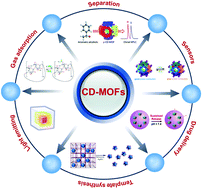Recent progress in the synthesis, structural diversity and emerging applications of cyclodextrin-based metal–organic frameworks
Abstract
Inorganic–organic hybrid materials, especially metal–organic frameworks (MOFs) composed of metals and organic linkers, have emerged as a new class of versatile materials owing to their tunable structure and controllable functionality. As typical biocompatible MOFs, cyclic oligosaccharide cyclodextrin-based carbohydrate metal–organic frameworks (CD-MOFs) have recently attracted considerable attention due to their edible, renewable and biodegradable nature. Herein, we focus on the latest advances concerning these materials. First, the synthesis methods and structural diversity of CD-MOFs are introduced and summarized. Besides, the synthetic strategies of moisture-resistant CD-MOFs are also emphasized. Moreover, their applications, including gas adsorption, separation, sensing, memristor fabrication, as templates in nanoparticle synthesis, light emission and especially drug delivery, are systematically discussed and highlighted. Finally, to conclude the review, some insights and current challenges that need to be addressed for the further development of these materials are proposed. We anticipate that this review will result in a better understanding of CD-MOFs and will help maximize the potential functions of these materials.

- This article is part of the themed collection: Recent Review Articles


 Please wait while we load your content...
Please wait while we load your content...